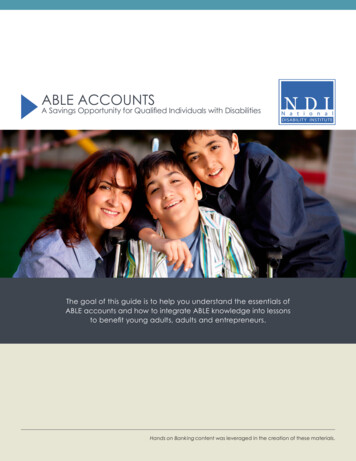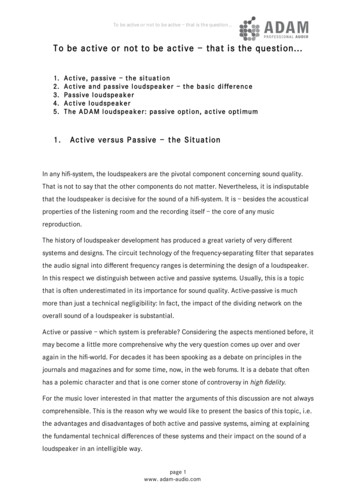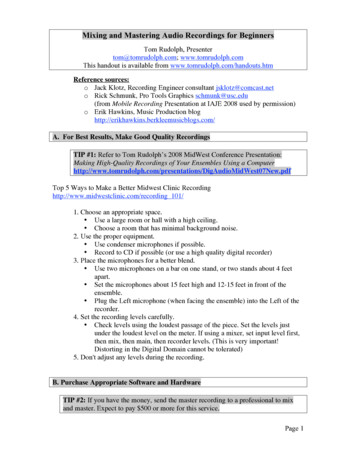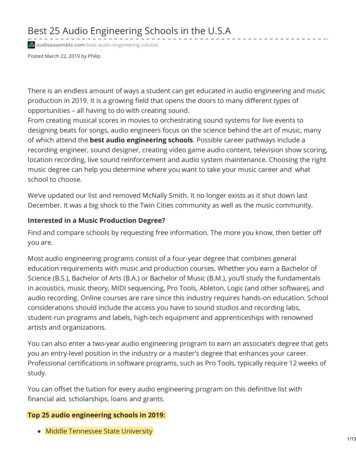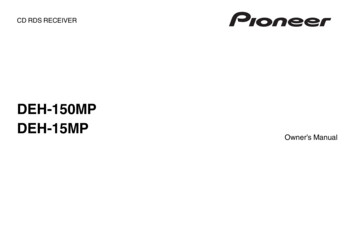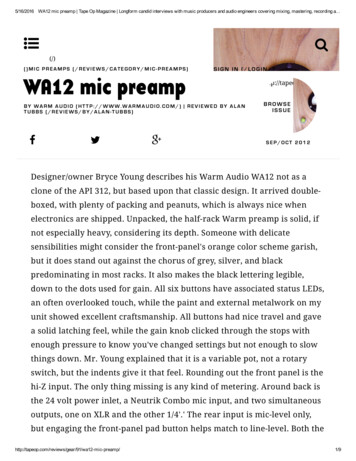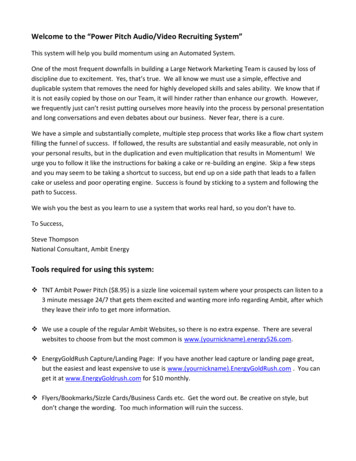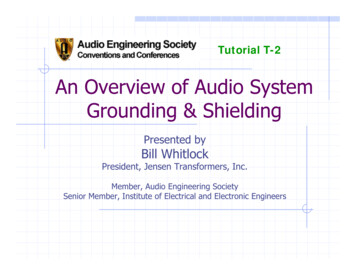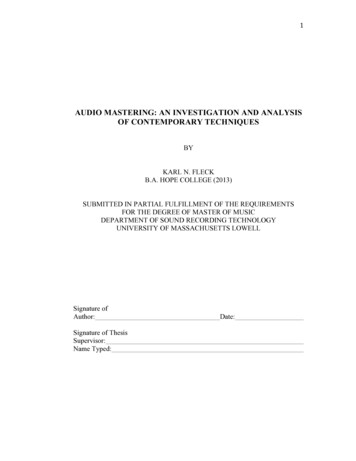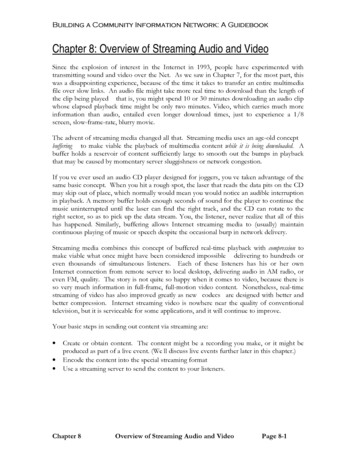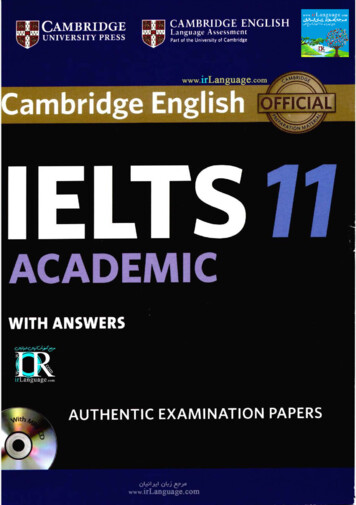
Transcription
DOWNLOADABLE AUDIOThis is your downloadable audio activation code:[R1rlanguagc-Do not share this activation code with anyone else.This code can only be used once.How do I activate my product?O Go to: www.cambridgelms.org/mainRegister on Cambridge Learning Management System (CLMS) as astudent and go to 'My Learning'.Click on 'Activate new product' and follow the instructions on screen.Teachers: Avoid delays - if you don't yet have a login for CLMS, register asa student for this download. You can upgrade/change to teacher accesslater with the help of your Cambridge University Press representative.System requirements:O Windows Vista, Windows 7, Windows 8, Windows 8.1O Mac OSX 10.8 and 10.9O JavaScript EnabledO Minimum 3Mbps Internet ConnectionMinimum browser versions supported:O Internet Explorer 10 and 11, Safari 6.0 and 7.0, most recent versions ofFirefox and ChromeSupported tabletsO iPad 4, optimised for iOS 7 and iOS 8 with SafariO Samsung Galaxy Tab 2 10.1, optimised for Android 4.2.2 with most recentversion of ChromePlease note:O Once the activation code has been revealed, this book cannot be returned.O This activation code can only be used once, is personal to you, and cannotbe re-used by anyone else.O Support for browsers and operating systems will vary over time. For thelatest information uestionsO Full terms and conditions are available at:www.cambridgelms.org/main/p/termsofuseu 1. .!1 u"'j .JDwww.irLanguage.com
CAMBRIDGEUNIVERSITY PRESS CAMBRIDGE ENGLISHLanguage AssessmentPart of the University of CambridgeACADEMICWITH ANSWERS.:., IJ:! I .:.,i.tj . " 15gS Lt o.c LJ:!I .:.WI O J4 "1 J.ob 9 -' .::,J "1. Ip J.oU. 9 .:.I .J I 9 e JA, ,.:., lJ.s .:.,T jl 15} .' AUTHENTIC EXAMINATION PAPERS,:, I .!I .:.,"'j {!:?. "www.IrLanguage.com
ContentsIntroductionTest 110Test 233Test 357Test 480Audioscripts4103Listening and Reading Answer KeysSample answers for Writing tasksSample answer sheetsAcknowledgements124132140t44u 1 .!1 u j /!::?. "www.irLanguage.com
ff "' 1rlanguage.-IntroductionThe International English Language Testing System (IELTS) is widely recognised asa reliable means of assessing the language ability of candidates who need to studyor work where English is the language of communication. These Practice Tests aredesigned to give future IELTS candidates an idea of whether their English is at therequired level.IELTS is owned by three partners, Cambridge English Language Assessment, part ofthe University of Cambridge, the British Council and IDP Education Pty Limited (throughits subsidiary company, IELTS Australia Pty Limited). Further information on IELTS canbe found on the IELTS website www.ielts.org.WHAT IS THE TEST FORMAT?IELTS consists of four components. All candidates take the same Listening and Speakingtests. There is a choice of Reading and Writing tests according to whether a candidate istaking the Academic or General Training module.AcademicFor candidates wishing to study atundergraduate or postgraduate levels,and for those seeking professionalregistration.General TrainingFor candidates wishing to migrate to anEnglish-speaking country (Australia, Canada,New Zealand, UK), and for those wishing totrain or study at below degree level.The test components are taken in the following order:.tafListening4 sections, 40 items approximately 30 minutesAcademic Reading3 sections, 40 items60 minutesorGeneral Training Reading3 sections, 40 items60 minutesAcademic Writing2 tasks60 minutesorGeneral Training Writing2 tasks60 minutesSpeaking11 to 14 minutesTotal Test Time2 hours 44 minutes4u 'Y-' u i {!.?- "www.irLanguage.com
IntroductionACADEMIC TEST FORMATListeningThis test consists of four sections, each with ten questions. The first two sections areconcerned with social needs. The first section is a conversation between two speakers andthe second section is a monologue. The final two sections are concerned with situationsrelated to educational or training contexts. The third section is a conversation between up tofour people and the fourth section is a monologue.A variety of question types is used, including: multiple choice, matching, plan/map/diagram labelling, form completion, note completion, table completion, flow-chart completion,summary completion, sentence completion, short-answer questions.Candidates hear the recording once only and answer the questions as they listen. Tenminutes are allowed at the end for candidates to transfer their answers to the answer sheet.ReadingThis test consists of three sections with 40 questions. There are three texts, which aretaken from journals, books, magazines and newspapers. The texts are on topics of generalinterest. At least one text contains detailed logical! argument.A variety of question types is used, including: multiple choice, identifying information(True/False/Not Given), identifying the writer's views/claims (Yes/No/Not Given), matchinginformation, matching headings, matching features, matching sentence endings, sentencecompletion, summary completion, note completion, table completion, flow-chart completion,diagram label completion, short-answer questions.WritingThis test consists of two tasks. It is suggested that candidates spend about 20 minutes onTask 1, which requires them to write at least 150 words, and 40 minutes on Task 2, whichrequires them to write at least 250 words. Task 2 contributes twice as much as Task 1 to theWriting score.Task 1 requires candidates to look at a diagram or some data (graph, table or chart) andto present the information in their own words. They are assessed on their ability to organise,present and possibly compare data, describe the stages of a process, describe an object orevent, or explain how something works.In Task 2, candidates are presented with a point of view, argument or problem. They areassessed on their ability to present a solution to the problem, present and justify an opinion,compare and contrast evidence and opinions, evaluate and challenge ideas, evidence orarguments.Candidates are also assessed on their ability to write in an appropriate style.More information on assessing the Writing test, including Writing Assessment Criteria(public version), is available on the IELTS website.5
IntroductionSpeakingThis test takes between 11 and 14 minutes and is conducted by a trained examiner.There are three parts:Part 1The candidate and the examiner introduce themselves. Candidates then answer generalquestions about themselves, their home/family, their job/studies, their interests and a widerange of similar familiar topic areas. This part lasts between four and five minutes.Part 2The candidate is given a task card with prompts and is asked to talk on a particular topic.The candidate has one minute to prepare and they can make some notes if they wish,before speaking for between one and two minutes. The examiner then asks one or twoquestions on the same topic.Part 3The examiner and the candidate engage in a discussion of more abstract issues which arethematically linked to the topic in Part 2. The discussion lasts between four and five minutes.The Speaking test assesses whether candidates can communicate effectively in English.The assessment takes into account Fluency and Coherence, Lexical Resource, GrammaticalRange and Accuracy, and Pronunciation. More information on assessing the Speaking test,including Speaking Assessment Criteria (public version), is available on the IELTS website.6
IntroductionHOW IS IELTS SCORED?IELTS results are reported on a nine-band scale. In addition to the score for overall languageability, IELTS provides a score in the form of a profile for each of the four skills (Listening,Reading, Writing and Speaking). These scores are also reported on a nine-band scale. Allscores are recorded on the Test Report Form along with details of the candidate's nationality,first language and date of birth. Each Overall Band Score corresponds to a descriptivestatement which gives a summary of the English language ability of a candidate classified atthat level. The nine bands and their descriptive statements are as follows:9 Expert User- Has fully operational command of the language: appropriate, accurate andfluent with complete understanding.8 Very Good User- Has fully operational command of the language with only occasionalunsystematic inaccuracies and inappropriacies. Misunderstandings may occur inunfamiliar situations. Handles complex detailed argumentation well.7 Good User - Has operational command of the language, though with occasionalinaccuracies, inappropriacies and misunderstandings in some situations. Generallyhandles complex language well and understands detailed reasoning.6 Competent User- Has generally effective command of the language despite someinaccuracies, inapprop riacies and misunderstandings. Can use and understand fairlycomplex language, particularly in familiar situations.5 Modest User - Has partial command of the language, coping with overall meaning inmost situations, though is likely to make many mistakes. Should be able to handle basiccommunication in own field.4 Limited User - Basic competence is limited to familiar situations. Has frequent problemsin understanding and expression. Is not able to use complex language.3 Extremely Limited User- Conveys and understands only general meaning in veryfamiliar situations. Frequent breakdowns in communication occur.2 Intermittent User - No real communication is possible except for the most basicinformation using isolated words or short formulae in familiar situations and to meetimmediate needs. Has great difficulty understanding spoken and written English.1 Non User- Essentially has no ability to use the language beyond possibly a few isolatedwords.O Did not attempt the test- No assessable information provided.7
IntroductionMARKING THE PRACTICE TESTSListening and ReadingThe Answer Keys are on pages 124-131.Each question in the Listening and Reading tests is worth one mark.Questions which require letter I Roman numeral answers For questions where the answers are letters or Roman numerals, you should write onlythe number of answers required. For example, if the answer is a single letter or numeralyou should write only one answer. If you have written more letters or numerals than arerequired, the answer must be marked wrong.Questions which require answers in the form of words or numbers Answers may be written in upper or lower case. Words in brackets are optional - they are correct, but not necessary. Alternative answers are separated by a slash (/). If you are asked to write an answer using a certain number of words and/or (a)number(s), you will be penalised if you exceed this. For example, if a question specifiesan answer using NO MORE THAN THREE WORDS and the correct answer is 'blackleather coat'. the answer 'coat of black leather' is incorrect. In questions where you are expected to complete a gap, you should only transfer thenecessary missing word(s) onto the answer sheet. For example, to complete 'in the . ',and the correct answer is 'morning'. the answer 'in the morning' would be incorrect. All answers require correct spelling (including words in brackets). Both US and UK spelling are acceptable and are included in the Answer Key. All standard alternatives for numbers, dates and currencies are acceptable. All standard abbreviations are acceptable. You will find additional notes about individual answers in the Answer Key.WritingThe sample answers are on pages 132-139. It is not possible for you to give yourself a markfor the Writing tasks. We have provided sample answers (written by candidates), showingtheir score and the examiner's comments. These sample answers will give you an insightinto what is required for the Writing test.8
IntroductionHOW SHOULD YOU INTERPRET YOUR SCORES?At the end of each Listening and Reading Answer Key you will find a chart which will helpyou assess whether, on the basis of your Practice Test results, you are ready to take theIELTS test.In interpreting your score, there are a number of points you should bear in mind. Yourperformance in the real IELTS test will be reported in two ways: there will be a Band Scorefrom 1 to 9 for each of the components and an Overall Band Score from 1 to 9, whichis the average of your scores in the four components. However, institutions consideringyour application are advised to look at both the Overall Band Score and the Bands foreach component in order to determine whether you have the language skills needed for aparticular course of study. For example, if your course has a lot of reading and writing, butno lectures, listening skills might be less important and a score of 5 in Listening might beacceptable if the Overall Band Score was 7. However, for a course which has lots of lecturesand spoken instructions, a score of 5 in Listening might be unacceptable even though theOverall Band Score was 7.Once you have marked your tests, you should have some idea of whether your listeningand reading skills are good enough for you to try the IELTS test. If you did well enough inone component, but not in others, you will have to decide for yourself whether you are readyto take the test.The Practice Tests have been checked to ensure that they are of approximately the samelevel of difficulty as the real IELTS test. However, we cannot guarantee that your score in thePractice Tests will be reflected in the real IELTS test. The Practice Tests can only give youan idea of your possible future perfonnance and it is ultimately up to you to make decisionsbased on your score.Different institutions accept different IELTS scores for different types of courses. We havebased our recommendations on the average scores which the majority of institutions accept.The institution to which you are applying may, of course, require a higher or lower score thanmost other institutions.Further informationFor
www.irLanguage.com General Training Reading 3 sections, 40 items 60 minutes General Training Writing 2 tasks 60 minutes . Introduction ACADEMIC TEST FORMAT Listening This test consists of four sections, each with ten questions. The first two sections are concerned with social needs. The first section is a conversation between two speakers and the second section is a monologue. The final two .
